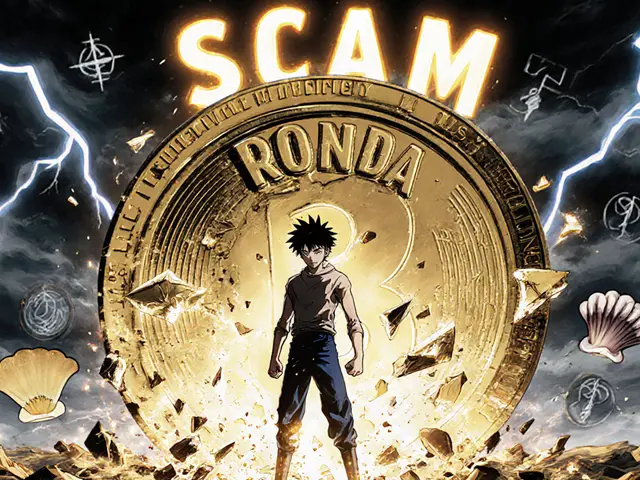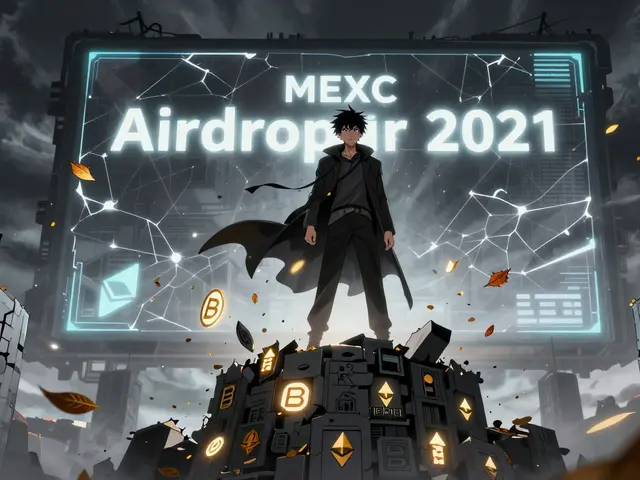Collateralization Safety Calculator
Understand how much of your leveraged position could be liquidated during a price drop. This tool helps you assess your risk before entering a trade or during volatile market conditions.
Your Position Risk Assessment
58,000 BTC liquidation cluster detected. If your position is near this level, risk increases significantly.
When Bitcoin dropped 50% in May 2021, over $28 billion in crypto positions vanished in under 48 hours. Not because investors panicked and sold - but because the system itself started eating its own tail. This isn’t a market correction. It’s a cascade liquidation.
Cascade liquidations don’t start with fear. They start with math. When the price of Bitcoin or Ethereum falls just enough to push leveraged positions below their collateral threshold, the protocol automatically sells those positions to cover losses. But here’s the catch: every forced sale adds more downward pressure. That pushes more positions underwater. Which triggers more sales. And so on. It’s a feedback loop that accelerates until liquidity dries up and prices collapse.
How Cascade Liquidations Actually Work
It starts with leverage. On many crypto exchanges, you can trade with 50x, 100x, even 125x leverage. That means a $1,000 deposit can control $100,000 in assets. Sounds powerful - until the market moves against you by just 1%.
Every leveraged position has a collateralization ratio. For example, if you borrow $50,000 worth of BTC using $75,000 in ETH as collateral, your ratio is 150%. Most platforms set the liquidation threshold at 110% to 130%. When your collateral value drops below that, the system triggers a forced sale.
But here’s what most traders miss: liquidations aren’t random. They cluster. Thousands of traders set their stop-losses or liquidation points at the same price - say, $58,000 for BTC. When the price hits that level, hundreds of positions get liquidated at once. That massive sell order floods the order book. Slippage spikes. Prices drop another 5%, triggering even more liquidations. Now you’re in a spiral.
During the October 2023 crash, over $19 billion was liquidated in a single day. That wasn’t because everyone suddenly lost faith in crypto. It was because a small dip hit a wall of clustered liquidations - and the system couldn’t absorb the shock.
Why Crypto Is So Vulnerable
Traditional markets have circuit breakers. When the S&P 500 drops 7%, trading pauses for 15 minutes. Crypto? No pauses. No breaks. 24/7 trading with no safety net.
Plus, liquidity is thin. On major DEXs like Uniswap or SushiSwap, liquidity pools for key pairs like ETH/BTC often hold less than $50 million during normal times. When a cascade hits, that pool gets drained in minutes. One trader’s $10 million liquidation can wipe out 20% of the entire order book.
And then there’s cross-asset collateral. In DeFi, you can use BTC as collateral to borrow ETH, or stablecoins to trade altcoins. That sounds efficient - until BTC crashes and suddenly your ETH position gets liquidated, even if ETH didn’t move. The collapse of Terra’s UST in May 2022 proved this: a stablecoin failure triggered liquidations across Aave, Compound, and MakerDAO - all because they shared the same collateral.
Traditional finance doesn’t have this. You can’t use your Tesla stock to borrow money to buy Netflix shares on margin and expect a drop in Tesla to wipe out your Netflix position. But in crypto? That’s standard.
What Happens When the System Breaks
Cascade liquidations don’t just lose you money. They break protocols.
When a position is liquidated, the system sells the collateral to cover the loan. But if there’s no buyer - because everyone’s selling - the protocol has to take the asset at a fire-sale price. That creates bad debt. In May 2021, some DeFi protocols ended up with millions in unrecoverable loans because the collateral was worth less than the debt after liquidation.
Slippage becomes monstrous. One Reddit user reported their 5x BTC long position got liquidated at 30% below their stop-loss price. Why? Because the order book was empty. The system tried to sell $2 million worth of BTC in one go - and the market couldn’t absorb it. The result? A $600,000 loss on a $100,000 position.
Even “safe” positions aren’t safe. A trader with 150% collateralization - twice the minimum - still got wiped out during the October 2023 crash. Why? Because the price dropped 20% in 20 minutes. The system liquidated at the next available price, which was 40% lower than the last trade.

How Traders Get Caught Off Guard
Most traders think they’re being careful. They use 5x leverage. They keep 150% collateral. They set stop-losses. But none of that matters if the market moves too fast.
Stop-loss orders often fail during cascades. Why? Because they rely on liquidity. If no one’s buying, your order just sits there - and your position gets liquidated anyway. One Bybit user on Trustpilot said their stop-loss at -15% executed at -98%. That’s not a glitch. That’s how the system works when liquidity vanishes.
Another trap: assuming your position is “safe” because it’s above the liquidation threshold. But thresholds are static. They don’t adapt to volatility. If BTC drops 15% in 10 minutes, your 140% ratio plummets to 115% - and suddenly you’re in the danger zone. No warning. No grace period.
And then there’s the herd effect. When you see “$10B liquidated” on Coinglass, it’s not just a number. It’s a signal. Other traders panic. They close positions. They sell collateral. That fuels the cascade. You’re not just fighting the market. You’re fighting a thousand others doing the same thing.
How to Protect Yourself
You can’t stop a cascade. But you can avoid being the one who gets eaten by it.
- Keep collateralization above 200% during high volatility. The minimum is 110%. That’s a trap. Aim for 200% or higher. That gives you breathing room.
- Avoid clustered liquidation zones. Use tools like Coinglass or Hyblock to see where most liquidations are clustered. If 80% of positions liquidate at $60,000, don’t hold leveraged positions near that price. Move your position higher or lower.
- Use lower leverage. 10x is dangerous. 5x is risky. 2x-3x is survivable. If you can’t afford to lose 50% of your position on a 10% move, you shouldn’t be leveraged.
- Don’t use cross-asset collateral. If you’re borrowing USDC using BTC as collateral, you’re tied to BTC’s fate. Even if you’re trading ETH, a BTC crash can kill you. Stick to same-asset collateral when possible.
- Monitor order book depth. If the bid side for BTC has less than $10 million in buy orders, don’t hold leveraged longs. The market can’t absorb a shock.
- Use limit orders, not market orders. If you’re closing a position, use a limit order. Even if it doesn’t fill, you control the price. Market orders during cascades are suicide.
Experienced traders say: if you’re sleeping during a 15% move, you’re already late. Set alerts. Watch the health factor. Know your liquidation price - not the protocol’s, but the real one, accounting for slippage.

What’s Being Done to Fix It
The industry is waking up. In late 2023, Chainlink launched Price Feeds 2.0 with circuit breakers. If a price moves more than 15% in 5 minutes, the feed pauses. That gives protocols time to react.
Binance introduced “liquidation smoothing” in February 2024. Instead of liquidating 1,000 positions all at once, they spread them over 5-minute intervals. That cut price impact by 27%.
Aave and Compound now increase liquidation penalties from 5% to 8% during extreme volatility. That discourages risky borrowing.
The Ethereum Foundation is testing “dynamic collateralization” - where margin requirements automatically rise as volatility spikes. Early simulations show it could reduce cascades by 40%.
But adoption is slow. Only 38% of DeFi users use health factor monitors. Most still rely on exchange defaults - which are designed for normal markets, not black swans.
The Bigger Picture
Cascade liquidations aren’t a bug. They’re a feature of how crypto was built: fast, global, leveraged, and unregulated. They’re the price of 24/7 trading and 100x leverage.
But they’re also the biggest threat to crypto’s future. If a single event wipes out $50 billion in one day, institutional investors will flee. Regulators will shut down exchanges. Public trust will collapse.
That’s why the CFTC is pushing for new rules in 2024 - mandatory circuit breakers, liquidity buffers, leverage caps. If crypto wants to go mainstream, it has to stop being a casino.
The next big cascade might come from a Fed rate hike, a Bitcoin ETF sell-off, or a stablecoin failure. It’s not a question of if - it’s when.
But here’s the truth: the traders who survive aren’t the ones with the biggest positions. They’re the ones who understand the system. Who know where the liquidation cliffs are. Who refuse to play with fire.
Markets recover. Positions don’t. If you want to stay in the game, treat leverage like a chainsaw - useful when you know how to use it, deadly when you don’t.
What causes cascade liquidations in crypto?
Cascade liquidations are triggered when a price drop pushes leveraged positions below their collateralization threshold, forcing automatic sales. These sales create more downward pressure, triggering additional liquidations in a self-reinforcing loop. They’re amplified by thin liquidity, clustered liquidation levels, and cross-asset collateral.
Can stop-loss orders protect me from cascade liquidations?
Usually not. During cascades, order books empty out. Stop-loss orders become market orders and execute at drastically worse prices - sometimes 30-50% below your intended level. Relying on them is risky. Use lower leverage and higher collateral instead.
What’s the difference between a normal liquidation and a cascade liquidation?
A normal liquidation is isolated - one position gets closed. A cascade is systemic - hundreds or thousands of positions liquidate at once, driving the price down further and triggering even more liquidations. Cascades turn individual failures into market-wide crashes.
Why do crypto markets have worse liquidations than traditional markets?
Crypto has higher leverage (up to 100x), no circuit breakers, 24/7 trading, thinner liquidity, and cross-asset collateral. Traditional markets cap leverage at 2-3x, pause trading during big drops, and have deeper order books. Crypto’s design makes cascades inevitable during volatility.
How can DeFi protocols prevent cascade liquidations?
Protocols can implement circuit breakers on price feeds, stagger liquidations over time (liquidation smoothing), increase liquidation penalties during volatility, and use dynamic collateralization ratios that rise with market risk. Chainlink, Aave, and Binance have already rolled out some of these features.
Is it possible to profit from cascade liquidations?
Some arbitrageurs and market makers try to buy assets during cascades when prices are artificially low. But this is extremely high-risk. Most retail traders get caught on the wrong side. The safest approach is to avoid leveraged positions entirely during volatile periods.
What should I do if I’m already in a leveraged position?
Check your collateralization ratio. If it’s below 200%, reduce leverage immediately. Avoid cross-asset collateral. Monitor liquidation clusters using tools like Coinglass. If volatility spikes, consider closing your position - even at a small loss. It’s better to lose 5% than 90%.









Comments (14)
Melina Lane
November 18, 2025 AT 13:03 PMJust kept my leverage at 2x and slept through the last crash. No drama, no tears. 🙌
Tim Lynch
November 18, 2025 AT 15:11 PMIt’s not about the math. It’s about the metaphysics of risk. We built a system that rewards speed and punishes patience - and then wonder why it collapses under its own weight. The market doesn’t break. We break it, by treating volatility like a feature and not a warning.
There’s a quiet dignity in not playing. In saying: I’d rather lose the game than become the game. Most won’t understand that until they’ve lost everything - and then they’ll blame the algorithm, not themselves.
But the real tragedy? We knew this was coming. We’ve seen it in 2017, 2018, 2021, 2022. And yet we keep doubling down on leverage like it’s a religion. The gods of DeFi don’t forgive. They just collect.
Maybe the real innovation isn’t in the protocols. Maybe it’s in the human capacity to wait. To sit still. To resist the siren song of 100x. That’s the only hedge that actually works.
And still… we reach for the fire.
andrew casey
November 19, 2025 AT 10:39 AMOne must observe, with the rigor of a classical economist and the precision of a quantum physicist, that the structural deficiencies inherent in decentralized leverage mechanisms are not merely suboptimal - they are ontologically unsound. The absence of circuit breakers constitutes a fundamental breach of fiduciary equilibrium in market microstructure.
It is, frankly, astonishing that any rational actor would entrust capital to a system where collateralization ratios are governed by brittle, static thresholds - a paradigm as archaic as the abacus in an age of quantum computing.
Moreover, the reliance upon cross-asset collateralization betrays a profound ignorance of systemic interdependence - a flaw so elementary, one wonders whether its proponents have ever read a single textbook on financial contagion.
One might reasonably conclude that the majority of retail participants in this space are not traders, but rather, unwitting participants in a grand, decentralized Ponzi of delusion.
Lani Manalansan
November 21, 2025 AT 05:36 AMI’ve been in crypto since 2016 and I’ve learned this: the people who last are the ones who don’t try to win every round.
My friend from Japan used to say, ‘In the ocean, the turtle survives because it doesn’t race the shark.’ That’s me. I don’t chase pumps. I don’t use leverage. I just hold BTC and ETH, and I check in once a week.
When everyone else is panicking, I make tea. When they’re yelling about liquidations, I’m reading a book.
It’s not sexy. But it’s mine.
And honestly? That’s enough.
Frank Verhelst
November 22, 2025 AT 13:53 PMBro, I just went from 5x to 1x after last crash 😭
Woke up with half my portfolio gone… now I just HODL and chill. No more stress. No more nightmares.
Life’s too short to cry over liquidations 💪❤️
Roshan Varghese
November 23, 2025 AT 17:09 PMlol u all think this is about leverage? nah. this is the fed. they pump the fiat, then crash crypto so they can buy the dip with your money. they control the price feeds. chainlink? owned by the same people who run the NYSE. you think you're trading crypto? you're trading their game.
and dont even get me started on how the cftc is just a puppet. they want you broke so they can regulate 'safe' crypto… which means only their buddies get to trade.
watch for the next 'crash' - it'll happen right after a fed meeting. mark my words. 🤫
Dexter Guarujá
November 24, 2025 AT 13:02 PMLook, if you’re dumb enough to use 50x leverage in a 24/7 market with no regulation, you deserve to lose. This isn’t Wall Street. This is the Wild West. And you’re the guy who brought a butter knife to a gunfight.
Stop blaming the system. Blame yourself. If you can’t handle volatility, go invest in bonds. Or better yet - go get a real job.
And don’t even get me started on ‘cross-asset collateral.’ That’s not innovation. That’s financial malpractice. If you can’t even manage your own risk, why should anyone trust you with crypto?
Jennifer Corley
November 25, 2025 AT 02:02 AMInteresting that you mention ‘circuit breakers’ as if they’re a solution. But have you considered that the real issue is the concentration of liquidation triggers? The data shows 80% of liquidations cluster within 2% of each other - which means exchanges and bots are deliberately manipulating price to hit those zones.
And yet, you blame the traders? No. You’re ignoring the architecture of predation. Who benefits when 19 billion vanishes? The market makers. The whales. The ones who placed their limit orders just below the clustering points.
It’s not a cascade. It’s a hunt.
Natalie Reichstein
November 25, 2025 AT 06:38 AMYou think you’re being careful with 200% collateral? You’re still a child playing with dynamite.
Real traders don’t rely on ratios. They rely on timing. They watch volume profiles. They track funding rates. They know when the market is rigged - and they stay out.
And if you’re using Coinglass to ‘avoid clustered zones’? That’s like using a GPS to avoid potholes while driving blindfolded.
The truth? You’re not protecting yourself. You’re just delaying the inevitable. The only safe position is no position.
Kaitlyn Boone
November 25, 2025 AT 13:50 PMlol i tried 5x once. lost 80% in 3 hours. now i just buy btc on dips and forget about it. no alerts no charts no stress.
also why do people think limit orders work during a crash? they dont. the order book is empty. the system just eats you. i learned the hard way. dont be me.
James Edwin
November 25, 2025 AT 18:54 PMI read this whole thing and kept thinking - why does no one talk about the psychological feedback loop? It’s not just the math. It’s the fear. When you see $10B liquidated, your brain says ‘this is it.’ So you sell. Even if you’re fine. Even if you’re above threshold. That’s what turns a dip into a crash.
What if the real solution isn’t technical? What if it’s cultural? What if we trained traders to treat volatility like weather - not a threat, but a condition?
Maybe we need a new mindset. Not better algorithms. Better minds.
Kris Young
November 27, 2025 AT 14:26 PMGood points. Very clear. I agree with the 200% collateral rule. Also, avoid cross-asset. Always. And use limit orders. Always. And check the order book. Always. And don’t use high leverage. Always. And monitor volatility. Always. And know your liquidation price. Always. And set alerts. Always.
Just remember: if you’re not doing all of these things, you’re not trading. You’re gambling.
LaTanya Orr
November 27, 2025 AT 21:36 PMI think the real question is not how to survive the cascade… but whether we should be building systems that create them in the first place
What does it say about us that we call this innovation when it’s really just a faster way to destroy wealth?
Maybe the future of crypto isn’t more leverage
but less noise
and more silence
Tim Lynch
November 29, 2025 AT 13:12 PMInteresting. You say ‘no position is safe’ - but that’s precisely the point. The system isn’t designed for safety. It’s designed for extraction. The only real safety is exit.
And yet… we keep coming back. Because the promise is too loud. The dream too bright. The fear of missing out louder than the fear of losing everything.
Maybe we’re not traders.
Maybe we’re addicts.
And the market? It’s just the dealer.